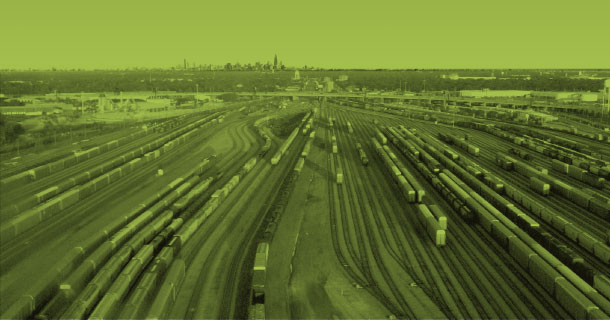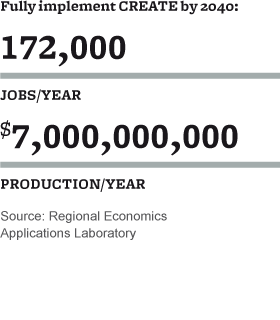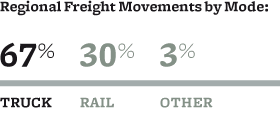Our freight system delivers everything that local businesses need to thrive—from raw materials for manufacturing to office supplies. Without the freight system we would be shut off from the rest of the world.
But freight travel can negatively impact our communities as well. While the consumption of goods carried on our freight network creates jobs and boosts our economy, the movement of goods by truck and train can also increase congestion, add to air pollution, and hold up traffic at rail crossings. Freight bottlenecks caused by inadequate infrastructure make it harder for commuters to reach their destinations and for companies to get their goods into and out of our region—which hurts our economy. The region must balance this inherent tension so freight traffic can serve as an engine of economic prosperity with minimal impact on local communities. We must overcome the financial and institutional barriers that hamper freight improvements — such as the challenge of coordinating multiple private carriers within a competitive industry— while working together to produce both public and private benefits.
Interactive mobility data visualizations highlight the need for an efficient freight network to support our region's transportation system. The increased investment in our freight system called for in GO TO 2040 will improve economic competitiveness by reducing travel delays and pollution and by improving safety. The private sector will fund some improvements through the normal course of business, but public investment is needed to promote economic growth as well as residents' health, safety, and welfare.
Our National Role Requires a Regional Voice
By any measure, our region is the nation's hub of rail and truck freight. Six of the nation's seven major railroads have large terminals here, with nearly 500 freight trains operating daily. But even more freight in our region moves by trucks, which carry about 1.5 billion tons of freight annually compared to 631 million tons by rail.
Despite being the leading U.S. freight center, metropolitan Chicago has not had a strong voice or a champion to look out for the public interest. National discussions and decisions about the movement of goods have traditionally been dominated by port cities and states.
The movement of goods is a regional issue more than a state one, and it is broader and more complex than a simple accumulation of the 284 municipal and seven county governments' individual interests. CMAP and its partners need to address economic needs and freight efficiency while assuring that metropolitan Chicago remains a place where skilled workers want to live and where businesses want to grow.


